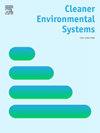秘鲁有机巧克力生产的生命周期评估
IF 4.9
Q2 ENGINEERING, ENVIRONMENTAL
引用次数: 0
摘要
在拉丁美洲,利用生命周期评估(LCA)对可可和巧克力生产的环境概况进行了有限的研究。目前的研究对秘鲁有机巧克力产品的生产进行了从摇篮到门的LCA分析,考虑了2022年位于秘鲁中部的21名女性生产者的可可种植实践。通过对技术人员进行问卷调查,在种植场地和加工厂现场收集数据。除了与种植、可可干运输和巧克力生产工厂的生产活动有关的化石和生物排放外,还模拟了可可和遮荫树在田间的碳捕获,并将其包括在碳平衡中。考虑到不同的环境因素,共选择了8个影响类别。使用主要情景的全球变暖结果显示,从每千克最终巧克力产品4.33千克二氧化碳当量到4.88千克二氧化碳当量的数值范围。大多数影响来自干可可豆的生产,在较小程度上来自上游的甘蔗生产。然而,当对单个可可生产者进行分析时,重要的差异是显而易见的,农林复合系统比可可单一作物的温室气体排放量更低。关于缺水问题,巧克力加工厂的活动比可可种植地的用水更严重。对于其他影响类别,由于不使用常规农药的农田的有机特性,耕作地点的毒性排放相对较低。可可豆收获后的管理(即堆肥)是温室气体排放的一个重要来源。因此,适当的堆肥条件可以使甲烷排放量保持在较低水平,但将豆荚直接送回田间可能会导致温室气体排放量大幅增加。如果遮荫在整个农田中均匀且足够密集,那么来自地上生物量(主要来自遮荫树和可可树)的碳固存似乎可以减轻这些排放的重要部分。本文章由计算机程序翻译,如有差异,请以英文原文为准。
Life cycle assessment of organic chocolate production in Peru
Limited studies have been conducted in Latin America related to the environmental profile of cocoa and chocolate production using Life Cycle Assessment (LCA). The current study conducts a cradle-to-gate LCA of the production of organic chocolate products in Peru, considering cocoa cultivation practices by a group of 21 female producers located in central Peru in the year 2022. Data were collected on-site at cultivation sites and processing plant using questionnaires with the technical staff. Beyond fossil and biogenic emissions linked to cultivation, transport of dried cocoa, and manufacturing activities at the chocolate producing plant, carbon capture on fields by cocoa and shading trees was modeled and included in the carbon balance. A total of 8 impact categories were selected, considering different environmental compartments. Results for global warming using the main scenario show a range of values from 4.33 kg CO2eq per kilogram of final chocolate product to 4.88 kg CO2eq. Most impacts are derived from the production of dry cocoa beans and, to a lesser extent, upstream sugarcane production. However, important differences were evident when the individual cocoa producers were analyzed, with agroforestry systems presenting lower greenhouse gas (GHG) emissions than cocoa monocrops. Regarding water scarcity, the activities at the chocolate processing plant were found to contribute more than water use at the cocoa cultivation sites. For other impact categories, toxicity emissions at the cultivation site were relatively low given the organic characteristics of the fields, which do not use conventional pesticides. The post-harvest management of the cocoa pods (i.e., composting) is a critical source of GHG emissions. Hence, adequate composting conditions maintain methane emissions low, but direct return of the pods to the field can generate a substantial increase in GHG emissions. Carbon sequestration from above ground biomass, mainly from shading and cocoa trees, appears to mitigate an important fraction of these emissions if shading is homogeneous and sufficiently dense across the fields.
求助全文
通过发布文献求助,成功后即可免费获取论文全文。
去求助
来源期刊

Cleaner Environmental Systems
Environmental Science-Environmental Science (miscellaneous)
CiteScore
7.80
自引率
0.00%
发文量
32
审稿时长
52 days
 求助内容:
求助内容: 应助结果提醒方式:
应助结果提醒方式:


